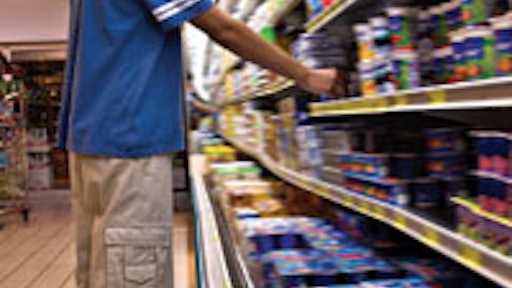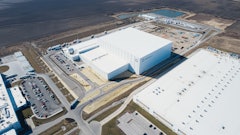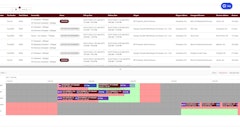
The perimeter departments of supermarkets have displayed considerable pizzazz with the sights and smells coming largely from the bakery and deli. Not surprisingly, shoppers gravitate to these departments, and then drift over to the alluring dairy with its healthy mix of products. They spend time and money on the perimeter, while typically spending as little time as possible roaming the center store.
This radical change in shopping behavior in recent years has raised the stakes for distribution to these fresh food departments. Products must be delivered on time, stock must remain fresh and shrink must be minimized.
So what is the state of distribution to the dairy/deli/bakery departments of food stores? The integrity of perishable products as they move through the supply chain has never been better, according to Joe Bove, a vice president in the distribution division of The Stellar Group, Jacksonville, FL.
"The certificate of authenticity and assurance, packing standards, bills of lading-which includes the shipping dates all the way down to the driver's name, the trailer number and product temperature-all that is captured unlike maybe even five years ago," he says.
"All of those are contributors to keeping products safer from a food quality and safety standpoint as well as preventing tampering with product through its logistics chain."
Clearly, distributing perishable products well can provide companies with a distinct competitive advantage.
"Excellence in distribution and traceability can position a great company to move quickly ahead of its peers. Not performing these core functions properly creates liabilities in safety, quality and ultimately the bottom line," says Rick Schmeisser, director of distribution for Reser's Fine Foods, Beaverton, OR. The company operates five major distribution centers specializing largely in fresh prepared foods bound for sale in the supermarket's deli case.
"For some time now, the trends of increasing regulation, higher transportation costs and increased customer-specific requests have forced food companies to create processes that improve service, ensure quality and also reduce costs," says Schmeisser, who has 15 years experience in starting up and managing distribution facilities for a mix of refrigerated, non-refrigerated and frozen products.
Monitoring Temperature
Reser's continually improves its processes and technology to meet the changing and growing needs of customers. The firm has added or improved programs to address segregation of items (by temperature type, product group, or lot code), RFID capability, standardizing temperature monitoring of outbound shipments and improving the traceability of cross dock freight as it moves through the system.
Not too long ago, Reser's noticed an increasing trend of customers requiring temperature monitoring of refrigerated products while in transit.
"Reser's number one challenge is to serve customers," recalled Schmeisser. "All improvements are driven from that premise and geared toward making receipt of our products easier, while not sacrificing our extremely short order cycle.
"Based upon our research, we noted that most of our competitors were having a large amount of refusals at receipt," he says. "Seeing an opportunity to gain a competitive edge, Reser's devoted an entire year into developing processes, procedures and systems."
They included:
- Devices were on each load where required. Systems work was done to add recorders as a line item and create flags for the warehouse to alert them, while being transparent to customers.
- Devices were properly started and at the correct temperature when employed. A process was instituted in which several checks were put in place and documentation required for the checks.
- Temperature was maintained during transit. Working with the Reser's transportation department, freight was routed in a new manner to ensure sensitive temperature items were placed on trucks with the least likelihood of failure.
Bove of Stellar's distribution division says there are different strategies to ensure food safety when supplying product to grocery stores. What's most important is keeping the refrigerated product cold all the way through the supply chain.
He says the process should involve having the manufacturer put finished goods into cold storage on site or off site, as well as during transportation and receiving on another dock. The last leg of the journey involves putting product on a refrigerated truck for delivery to a store.
"It's hard to account for all those touches, if you will," he says. "But with some new technologies, there are ways to ensure better quality and safer food," he says.
One strategy, he explained, would be multi-vendor consolidation or a pooled distribution. In such cases, manufacturers are shipping into a hub and less-than-full pallets of product are being custom built. The replenishment of retail comes through the multi-vendor consolidation warehouse. The orders are picked and then forwarded to the end user. In this process, the end user does not need much storage; in fact, it can be a just-in-time delivery.
"One of the food safety advantages with the multi-vendor consolidation is the fact that one person is responsible for that whole delivery chain," says Stellar's Bove. "You can ensure that the dock time is minimized, the temperatures on the dock are controlled and the temperature of the product on the truck is controlled. That relates to warehouse management systems and barcoding, and RFID-having tags on pallets and having checkpoints."
In addition to these forms of data capture, Bove says more companies are using digital photography to capture, say, the condition of products on a pallet.
"If you want to enforce policy and attest to the fact that product was kept on a dock at a certain temperature, you could take a thermometer and put it on top of the pallet or in front of the pallet. You could take a photograph of the thermometer and the license tag of that pallet and essentially show that the temperature was accurate."
Preparing Retailers
Another strategy is to provide advance shipping notices to retailers so they can prepare their shelving. By knowing what's coming, they can be ready.
"I think there are advantages in quality assurance," says Bove. "The buyer is looking at product and if there are shorts or poor performing products, they're aware of it immediately and they may not buy.
"So I think there's some advantage there," he summed. "And I think that makes for better product for the end consumer. You're getting that data and information to the store buyer who knows what people like and what the consumer demands. I think that's very powerful. It plays into quality assurance and food safety."
Recent work by Stellar and Reser's attest to the growing sophistication of quality control in perishable distribution from the plant to the shelf. And it bodes well for the future.
Stellar has worked with the top twenty refrigerated warehouse distribution companies, as well as with top food and beverage manufacturers such as General Mills, Nestle and Pepsi. Bove says those companies are committed to advanced management systems and "they do a lot of synchronized business, more like a DSD strategy."
Recent projects included expansion at Maplehurst Bakeries in Brownsburg, IN and at Schreiber Foods in Stephenville, TX. The latter involved adding 165,000 sq. ft. to the existing cream cheese processing plant dedicated to processing, storing and distributing natural and processed cheese products.
"By examining the needs of our customers, we are able to quickly identify required systems and processes to implement," says Schmeisser of Reser's. "Our customer service culture responds well to constantly changing requirements."



























